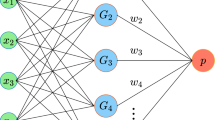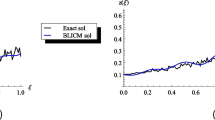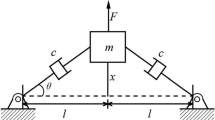Abstract
This paper presents a method for forecasting Hopf bifurcations and the post-bifurcation dynamics in complex large-dimensional nonlinear systems. This method is based on the phenomenon of critical slowing down and the projection of the system dynamics on the center space. The approach does not require a model of the system because forecasting is based only on time-series measurements of the system response to perturbations (only) in the pre-bifurcation regime. Techniques are introduced to increase forecasting accuracy and to enable the use of data from recoveries after large perturbations. In contrast to other existing methods, the proposed technique solves the problem of insufficient data due to low-frequency system oscillations. The proposed approach is applied to a nonlinear aeroelastic system which is exposed to gust loads. Numerical simulations show that the method accurately predicts the bifurcation point, the bifurcation type, and the post-bifurcation dynamics in both supercritical and subcritical cases despite the fact that it uses only pre-bifurcation regime data and it does not use a model of the system.




















Similar content being viewed by others
References
Lee, B.H.K., Jiang, L.Y., Wong, Y.S.: Flutter of an airfoil with a cubic restoring force. J. Fluid Struct. 13, 75–101 (1999)
Kalmár-Nagy, T., Gábor, S., Francis, C.M.: Subcritical Hopf bifurcation in the delay equation model for machine tool vibrations. Nonlinear Dyn. 26(2), 121–142 (2001)
Jafri, F.A., Shukla, A., Thompson, D.F.: A numerical bifurcation study of friction effects in a slip-controlled torque converter clutch. Nonlinear Dyn. 50(3), 627–638 (2007)
Fussmann, G.F., Ellner, S.P., Shertzer, K.W., Hairston Jr., N.G.: Crossing the Hopf bifurcation in a live predator-prey system. Science 290(5495), 1358–1360 (2000)
Mees, A., Chua, L.O.: The Hopf bifurcation theorem and its applications to nonlinear oscillations in circuits and systems. IEEE Trans. Circuits Syst. 26(4), 235–254 (1979)
Huang, C., Huang, L., Feng, J., Nai, M., He, Y.: Hopf bifurcation analysis for a two-neuron network with four delays. Chaos Solitons Fractals 34(3), 795–812 (2007)
Scheffer, M., et al.: Early-warning signals for critical transitions. Nature 461(7260), 53–59 (2009)
Jeffries, C., Wiesenfeld, K.: Observation of noisy precursors of dynamical instabilities. Phys. Rev. A 31(2), 1077–1084 (1985)
Guttal, V., Jayaprakash, C.: Changing skewness: an early warning signal of regime shifts in ecosystems. Ecol. Lett. 11(5), 450–460 (2008)
Horsthemke, W.: Noise Induced Transitions. Springer, Berlin (1984)
Wiesenfeld, K.: Virtual Hopf phenomenon: a new precursor of period-doubling bifurcations. Phys. Rev. A 32(3), 1744 (1985)
Chisholm, R.A., Filotas, E.: Critical slowing down as an indicator of transitions in two-species models. J. Theor. Biol. 257(1), 142–149 (2009)
Van Nes, E.H., Scheffer, M.: Slow recovery from perturbations as a generic indicator of a nearby catastrophic shift. Am. Nat. 169(6), 738–747 (2007)
Carpenter, S.R., Brock, W.A.: Rising variance: a leading indicator of ecological transition. Ecol. Lett. 9(3), 311–318 (2006)
Lim, J., Epureanu, B.I.: Forecasting a class of bifurcations: theory and experiment. Phys. Rev. E 83(1), 016203 (2011)
Lim, J., Epureanu, B.I.: Forecasting bifurcation morphing: application to cantilever-based sensing. Nonlinear Dyn. 67(3), 2291–2298 (2012)
Sieber, J., Thompson, J.M.T.: Nonlinear softening as a predictive precursor to climate tipping. Philo. Trans. R. Soc. A 370(1962), 1205–1227 (2012)
Thompson, J.M.T., Sieber, J.: Climate tipping as a noisy bifurcation: a predictive technique. IMA J. Appl. Math. 76(1), 27–46 (2011)
Thompson, J.M.T., Sieber, J.: Predicting climate tipping as a noisy bifurcation: a review. Int. J. Bifurc. Chaos 21(02), 399–423 (2011)
D’Souza, K., Epureanu, B.I., Pascual, M.: Forecasting bifurcations from large perturbation recoveries in feedback ecosystems. PLoS One 10(9), e0137779 (2015)
Ghadami, A., Epureanu, B.I.: Forecasting subcritical and supercritical flutter using gust responses. In: International Mechanical Engineering Congress & Exposition (IMECE 2015)
Zhou, W., Chelidze, D.: Generalized eigenvalue decomposition in time domain modal parameter identification. J. Vib. Acoust. 130(1), 011001 (2008)
Juang, J.N., Pappa, R.S.: An eigensystem realization algorithm for modal parameter identification and model reduction. J. Guid. Control Dyn. 8(5), 620–627 (1985)
Pappa, R.S.: Eigensystem realization algorithm user’s guide for VAX/VMS computers. NASA TM, 109066 (1994)
Lenci, S., Consolini, L., Clementi, F.: On the experimental determination of dynamical properties of laminated glass. Ann. Solid Struct. Mech. 7(1–2), 27–43 (2015)
Lee, B.H.K., Gong, L., Wong, Y.S.: Analysis and computation of nonlinear dynamic response of a two-degree-of-freedom system and its application in aeroelasticity. J. Fluid Struct. 11(3), 225–246 (1997)
Fung, Y.C.: An Introduction to the Theory of Aeroelasticity. Courier Corporation, North Chelmsford (2002)
Dessi, D., Mastroddi, F.: A nonlinear analysis of stability and gust response of aeroelastic systems. J. Fluid Struct. 24(3), 436–445 (2008)
Marzocca, P., Librescu, L., Chiocchia, G.: Aeroelastic response of 2-D lifting surfaces to gust and arbitrary explosive loading signatures. Int. J. Impact Eng. 25(1), 41–65 (2001)
Chow, J.H., Wu, F.F., Momoh, J.A.: Applied mathematics for restructured electric power systems. Springer, New York (2005)
Waugh, I., Illingworth, S., Juniper, M.: Matrix-free continuation of limit cycles for bifurcation analysis of large thermoacoustic systems. J. Comput. Phys. 240, 225–247 (2013)
Jezequel, L., Lamarque, C.H.: Analysis of non-linear dynamical systems by the normal form theory. J. Sound Vib. 149(3), 429–459 (1991)
Neild, S.A., Champneys, A.R., Wagg, D.J., Hill, T.L., Cammarano, A.: The use of normal forms for analysing nonlinear mechanical vibrations. Philo. Trans. R. Soc. A 373(2051), 20140404 (2015)
Nayfeh, A.H.: The Method of Normal Forms. Wiley, New York (2011)
Acknowledgements
The authors acknowledge the National Science Foundation for the generous support of this work (Grant 1334908).
Author information
Authors and Affiliations
Corresponding author
Appendix
Appendix
Consider the following damped single degree of freedom nonlinear system. For clarity, the nonlinearity is assumed to be cubic as
Writing this equation in state space form gives
where the states are chosen to be position and velocity.
Next, define the following transformation
where \(\mathbf{x}\) is the state variables vector(\(\mathbf{x}=[{\begin{array}{ll} x&{} {{\dot{x}}} \\ \end{array} }]^{T}), \mathbf{y}\) is vector containing the complex modal coordinates \(\mathbf{y}=[{\begin{array}{ll} {y_1 }&{} {y_2 } \\ \end{array} }]^{T}\), and \(\Phi \) is the matrix of complex mode shapes of the system. Matrix \(\Phi \) can be written as
where \(\lambda _1 =(-c-ir)/2\), and \(r=\sqrt{4\omega ^{2}-c^{2}}\).
Substituting (26) into (25), solving for \(y_1 \) and \(y_2 \), and defining \(a=\lambda _1 +i\omega \), one obtains the following expressions which can be used in the normal form theory
Next, one may introduce the following nonlinear change of coordinates
Using normal form theory, one can show that the system can be transformed using Eq. (29) into the following normal form up to \(3^{\mathrm{rd}}\) order
The solution of above system of equations is in the following periodic form
where \(u_0 \) is a complex number, and \({\tilde{\omega }} \) is real number in the following form
Now, using Eqs. (31) and (29), one may observe that \(y_1 \) and \(y_2 \) are complex conjugates. Substituting Eq. (31) into Eq. (29) and assuming small nonlinearities, one can obtain an approximation for the modal coordinates in the following form
where \(w_1 (t)\) and \(w_2 (t)\) are functions of time containing exponentially decaying functions and the recovery rate of the system. Following the same procedure as in Eq. (33), one finds that both \(w_1 (t)\) and \(w_2 (t)\) have the same decay rate. The real and imaginary parts of the expression on the right-hand side of Eq. (33) correspond to \(q_1 \) and \(q_2 \) used in the text as real valued modal coordinates, i.e.
Note that \(q_1\) and \(q_2\) are in quadrature and form a regular spiral in the \(q_1 -q_2\) plane; the same form as expressed in Eq. (11). Note also that this conclusion came from the fact that the modal bases were chosen to be position and velocity.
The above procedure can be extended to higher-order systems and nonlinearities. More details can be found in refs. [32,33,34].
Rights and permissions
About this article
Cite this article
Ghadami, A., Epureanu, B.I. Forecasting the post-bifurcation dynamics of large-dimensional slow-oscillatory systems using critical slowing down and center space reduction. Nonlinear Dyn 88, 415–431 (2017). https://doi.org/10.1007/s11071-016-3250-y
Received:
Accepted:
Published:
Issue Date:
DOI: https://doi.org/10.1007/s11071-016-3250-y




